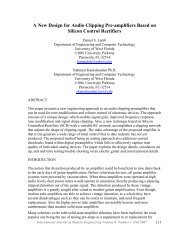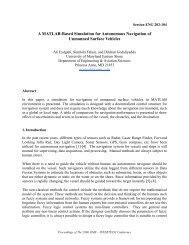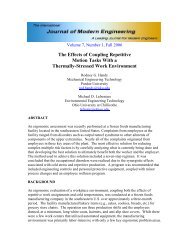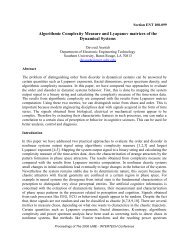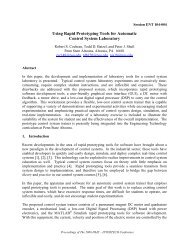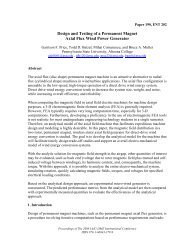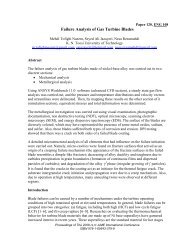WIP: A Study on the Development of Endodontic Micro Robot - IJME
WIP: A Study on the Development of Endodontic Micro Robot - IJME
WIP: A Study on the Development of Endodontic Micro Robot - IJME
You also want an ePaper? Increase the reach of your titles
YUMPU automatically turns print PDFs into web optimized ePapers that Google loves.
This paper will focus <strong>on</strong> <strong>the</strong> preliminary study <strong>of</strong> <strong>the</strong> mechanical design <strong>of</strong> an endod<strong>on</strong>tic<br />
robot, <strong>the</strong> choosing and fabricati<strong>on</strong> <strong>of</strong> embedded sensors, and <strong>the</strong> design <strong>of</strong> <strong>the</strong> c<strong>on</strong>trol<br />
system with an NC c<strong>on</strong>troller for robotic moti<strong>on</strong>.<br />
ESSENCES IN ENDODONTIC PROCESS AUTOMATION<br />
Root canal shaping is a mechanical process that is currently d<strong>on</strong>e with hand files and<br />
reamers, al<strong>on</strong>g with drills <strong>of</strong> various designs and tools that attach to rotary engines <strong>of</strong><br />
different speeds. In principle, though not in scale, it does not differ from <strong>the</strong><br />
drilling/reaming process in <strong>the</strong> machining industry. The machining industry has moved<br />
from manual operati<strong>on</strong> to Numerical C<strong>on</strong>trol (NC) and Computer Numerical C<strong>on</strong>trol<br />
(CNC). The quality and accuracy <strong>of</strong> a produced part is c<strong>on</strong>trolled by a computer program<br />
<strong>on</strong> an automatic precisi<strong>on</strong> machine. This master skill, so critical in <strong>the</strong> past, is no l<strong>on</strong>ger<br />
needed. Currently in endod<strong>on</strong>tics, <strong>the</strong> success <strong>of</strong> <strong>the</strong> root canal shaping principally<br />
depends <strong>on</strong> <strong>the</strong> skill and thoroughness <strong>of</strong> <strong>the</strong> clinician. This is because endod<strong>on</strong>tic<br />
<strong>the</strong>rapy relies almost entirely <strong>on</strong> “feel” - <strong>the</strong> tactile sense <strong>of</strong> <strong>the</strong> clinicians [7]. The quality<br />
and accuracy <strong>of</strong> clinical care could be greatly enhanced by applying available<br />
technological advancements, such as process automati<strong>on</strong> with NC c<strong>on</strong>trolled micro robot,<br />
to this <strong>the</strong>rapy.<br />
The tasks to develop this micro robot include:<br />
(1) Defining <strong>the</strong> specificati<strong>on</strong>s and requirements for this robot;<br />
(2) Mechanical design, manufacture, and mounting <strong>of</strong> <strong>the</strong> robot;<br />
(3) Design, select or fabricati<strong>on</strong> <strong>the</strong> sensors and actuators;<br />
(4) Design and development <strong>of</strong> <strong>the</strong> c<strong>on</strong>trol system.<br />
ENDODONTIC MICRO ROBOT SPECIFICATIONS AND REQUIREMENTS<br />
Specific objectives for micro robot design include: (1) reducing <strong>the</strong> reliance <strong>on</strong> <strong>the</strong> skills<br />
<strong>of</strong> <strong>the</strong> dentist, (2) minimizing human error, and (3) <strong>of</strong>fering a method for precise<br />
diagnosis and treatment.<br />
In order to determine <strong>the</strong> engineering features for <strong>the</strong> micro robot, a survey was<br />
developed and sent to dentists and endod<strong>on</strong>tists in <strong>the</strong> greater Cincinnati area [8]. The<br />
survey results indicate that <strong>the</strong> machine should have <strong>the</strong> following features:<br />
• A micro-positi<strong>on</strong> and orientati<strong>on</strong> adjustment to ensure that <strong>the</strong> tools start at a<br />
precise point;<br />
• An automatic feed rate and travel distance c<strong>on</strong>trol to ensure that <strong>the</strong> tools can<br />
reach <strong>the</strong> required canal depth and stop at a designated point;<br />
• Built-in micro sensors to m<strong>on</strong>itor <strong>the</strong> probing and drilling/reaming process;<br />
• Apex sensing and c<strong>on</strong>trol to prevent root perforati<strong>on</strong>s or <strong>the</strong> potential to over<br />
shoot (exceeding <strong>the</strong> apex <strong>of</strong> <strong>the</strong> canal);<br />
• Flexible drills or files to allow for cleaning and shaping curved canals;<br />
Internati<strong>on</strong>al Journal <strong>of</strong> Modern Engineering Volume 8, Number 1 Fall 2007 29



